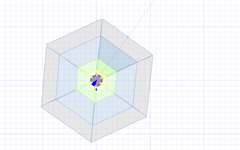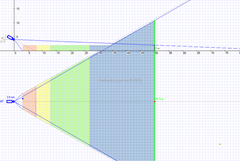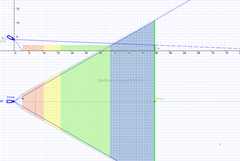The following page is related to the Linkedin posts on CCTV for ID quality about achieving coverage in council areas with fixed position cameras instead of PTZ cameras.
Diagram 1 shows the coverage of a 1.3MP 4:3 aspect IP camera with a 65 degree lens for use in a council area that wants 360 degree coverage. This requires 6 cameras to obtain full coverage, as shown in diagram 2.
The main purpose of fixed position cameras instead of PTZ’s is to record where no operator is present to control the PTZ. As such, the camera should be able to give a quality level to recognise someone you know in the scene at a reasonable distance from the cameras.
The cameras in this illustration can see out to 50mtrs at a 2mtr height so a persons full body is in the scene.
In Diagram 1 & 2, the coloured areas indicate the different levels of identification that can be achieved. Click the images to see a higher resolution image.
[easyazon-block asin=”B001DSSJJ2″ align=”right”]Pink – Identify someone you do not know
Yellow – Recognise someone you do know
Blue – Detect activity to a level to be able to say what they are doing but not recognise the person
Grey – Monitor that a person is in the scene but not be able to define what they are doing or who they are
So for the above camera, we can identify the person at 4.5 mtrs, recognise them to 8 mtrs. Beyond that we do not know who they are, which is not really ideal for a council area unless the person walks right up to the camera.
Diagram 3 below shows the same coverage but with a 3MP canera. The results only slightly better for twice the resolution.
Identify the person at 8 mtrs, recognise them to 13 mtrs.
And finally diagram 4 below shows the same coverage but with a 5MP camera. The results only slightly better for twice the resolution.
Identify the person at 10.5 mtrs, recognise them to 16.5 mtrs.
The problem of going beyond 1.3MP is the low light performance of the camera rolls of very quickly and the bandwidth/storage requirements climb.
Each camera in a typical council scene, recording at 12ips for 30 days will require around the following storage
- 1.3MP – 732GB
- 3MP – 1.7TB
- 5MP – 2.7TB
So when selecting a system design, knowing what you really are wanting to cover is critical unless you just want an overview of what is happening but not who is doing it. In the real world, there will often be cameras in different locations that you are likely to walk past so the probability of getting an ID shot increases even if the camera you were seen committing a crime under was not able to give the desired image.
All diagrams were created using the ‘IP Video System Design Tool‘ 3D drawing software by JVSG




